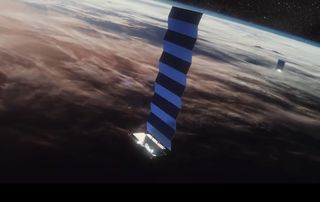Hawaiian Airlines to use SpaceX's Starlink internet on trans-Pacific flights
It's the second in-flight airline deal for SpaceX in recent days.

SpaceX has secured another airline customer for its Starlink internet service.
Hawaiian Airlines will use Starlink to provide Wi-Fi on its trans-Pacific flights, the company announced on Monday (April 25).
"We waited until technology caught up with our high standards for guest experience, but it will be worth the wait," Peter Ingram, the airline's president and CEO, said in a statement. "Our guests can look forward to fast, seamless and free Wi-Fi to complement our award-winning onboard Hawaiian hospitality."
The value of the deal was not disclosed in the press release. This is the second major Starlink inflight Wi-Fi announcement in recent days; charter airline company JSX said last week it would offer the service on its Embraer ERJ aircraft, which is generally used by well-heeled business customers.
Related: SpaceX's Starlink satellite megaconstellation launches in photos
We're proud to be the 1st major U.S. airline to select @SpaceX’s Starlink, which will provide the best internet connectivity in the air — free for our guests. Stay connected from the comfort of your seat. This is the future of flying.✨ https://t.co/ZBTwso36Kq.#Starlink #SpaceX pic.twitter.com/qxV2tRd4diApril 25, 2022
Hawaiian is the first major airline to sign up with Starlink, although it's not the only one eying the service for customers. Delta Airlines told the Wall Street Journal recently that it has conducted "exploratory tests" of Starlink's internet technology for its business customers.
Back in 2021, SpaceX founder and CEO Elon Musk said SpaceX was working on making Starlink service available on various aircraft, although it appears the vehicles on his list at the time were not the ones first certified for use with his company's service.
Get the Space.com Newsletter
Breaking space news, the latest updates on rocket launches, skywatching events and more!
"Schedule driver there is regulatory approval," Musk tweeted on June 25, alluding to the Federal Aviation Administration that oversees the airline industry. "Has to be certified for each aircraft type. Focusing on 737 & A320, as those serve most number of people, with development testing on Gulfstream."

Starlink is a good choice for rural or remote customers (presumably including airline clients) who are looking for better internet connectivity, SpaceX representatives say.
"Users can expect to see download speeds between 100 Mb/s and 200 Mb/s, and latency as low as 20ms in most locations," the Starlink home page states of its service to ground terminals. The page does not say what those speeds might be at 30,000 feet (9 kilometers) above Earth.
SpaceX regularly sends Starlink satellites to orbit aboard the company's Falcon 9 rockets. SpaceX now has launched more than 2,300 Starlink satellites and may eventually send up about 30,000. The megaconstellation's potential impact on launch services, astronomy and space debris are a cause of concern among scientists and other stakeholders in the community.
Follow Elizabeth Howell on Twitter @howellspace. Follow us on Twitter @Spacedotcom or on Facebook.
Join our Space Forums to keep talking space on the latest missions, night sky and more! And if you have a news tip, correction or comment, let us know at: community@space.com.

Elizabeth Howell (she/her), Ph.D., is a staff writer in the spaceflight channel since 2022 covering diversity, education and gaming as well. She was contributing writer for Space.com for 10 years before joining full-time. Elizabeth's reporting includes multiple exclusives with the White House and Office of the Vice-President of the United States, an exclusive conversation with aspiring space tourist (and NSYNC bassist) Lance Bass, speaking several times with the International Space Station, witnessing five human spaceflight launches on two continents, flying parabolic, working inside a spacesuit, and participating in a simulated Mars mission. Her latest book, "Why Am I Taller?", is co-written with astronaut Dave Williams. Elizabeth holds a Ph.D. and M.Sc. in Space Studies from the University of North Dakota, a Bachelor of Journalism from Canada's Carleton University and a Bachelor of History from Canada's Athabasca University. Elizabeth is also a post-secondary instructor in communications and science at several institutions since 2015; her experience includes developing and teaching an astronomy course at Canada's Algonquin College (with Indigenous content as well) to more than 1,000 students since 2020. Elizabeth first got interested in space after watching the movie Apollo 13 in 1996, and still wants to be an astronaut someday. Mastodon: https://qoto.org/@howellspace
